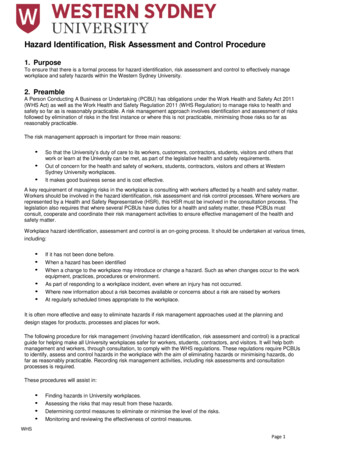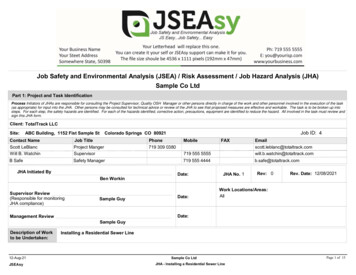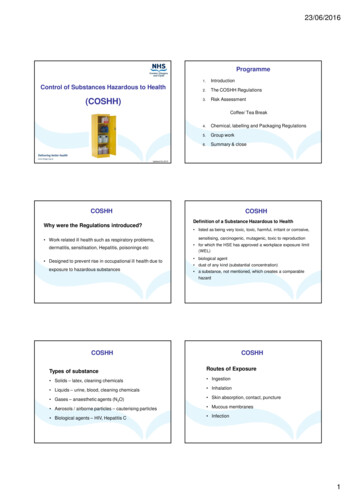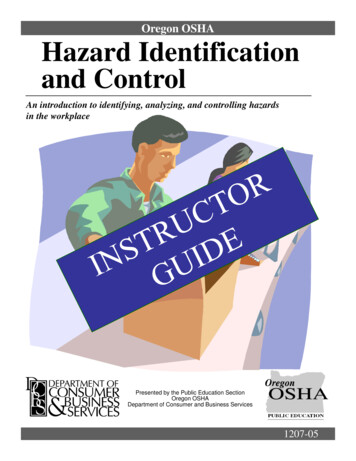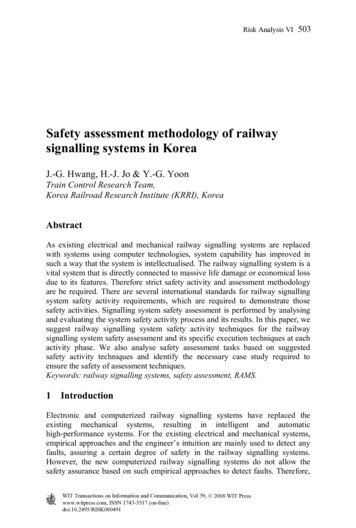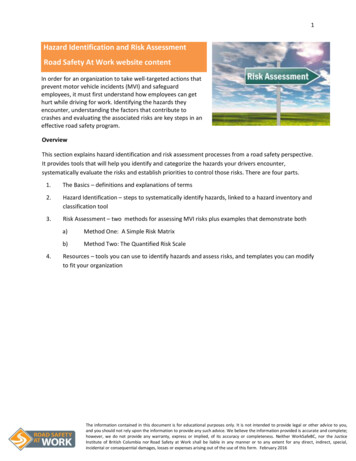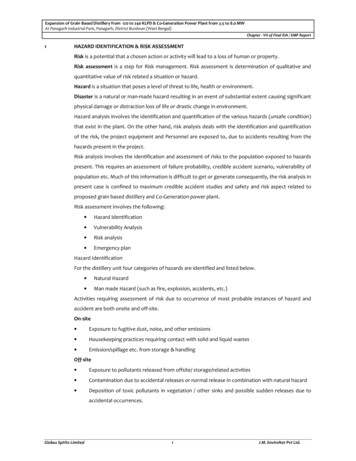
Transcription
Expansion of Grain Based Distillery from 120 to 240 KLPD & Co-Generation Power Plant from 3.5 to 8.0 MWAt Panagarh Industrial Park, Panagarh, District Burdwan (West Bengal)Chapter - VII of Final EIA / EMP Report1HAZARD IDENTIFICATION & RISK ASSESSMENTRisk is a potential that a chosen action or activity will lead to a loss of human or property.Risk assessment is a step for Risk management. Risk assessment is determination of qualitative andquantitative value of risk related a situation or hazard.Hazard is a situation that poses a level of threat to life, health or environment.Disaster is a natural or man-made hazard resulting in an event of substantial extent causing significantphysical damage or distraction loss of life or drastic change in environment.Hazard analysis involves the identification and quantification of the various hazards (unsafe condition)that exist in the plant. On the other hand, risk analysis deals with the identification and quantificationof the risk, the project equipment and Personnel are exposed to, due to accidents resulting from thehazards present in the project.Risk analysis involves the identification and assessment of risks to the population exposed to hazardspresent. This requires an assessment of failure probability, credible accident scenario, vulnerability ofpopulation etc. Much of this information is difficult to get or generate consequently, the risk analysis inpresent case is confined to maximum credible accident studies and safety and risk aspect related toproposed grain based distillery and Co-Generation power plant.Risk assessment involves the following: Hazard Identification Vulnerability Analysis Risk analysis Emergency planHazard IdentificationFor the distillery unit four categories of hazards are identified and listed below. Natural Hazard Man made Hazard (such as fire, explosion, accidents, etc.)Activities requiring assessment of risk due to occurrence of most probable instances of hazard andaccident are both onsite and off-site.On-site Exposure to fugitive dust, noise, and other emissions Housekeeping practices requiring contact with solid and liquid wastes Emission/spillage etc. from storage & handlingOff-site Exposure to pollutants released from offsite/ storage/related activities Contamination due to accidental releases or normal release in combination with natural hazard Deposition of toxic pollutants in vegetation / other sinks and possible sudden releases due toaccidental occurrences.Globus Spirits Limited1J.M. EnviroNet Pvt Ltd.
Expansion of Grain Based Distillery from 120 to 240 KLPD & Co-Generation Power Plant from 3.5 to 8.0 MWAt Panagarh Industrial Park, Panagarh, District Burdwan (West Bengal)Chapter - VII of Final EIA / EMP Report1.1Risk Analysis MethodologiesRisk assessment often requires the synthesis of risk profiles, which represent the probabilitydistribution of total annual loss due to a certain set of events or activities. These assessments usuallyinvolve estimation of losses for several sub-classifications of the overall process and synthesis of theresults into an aggregate risk profile.Main risk assessment technologies are:Hazard and operability study (HAZOP)- The hazop study is a systematic technique of identifyinghazards of operability problems of a process and lists all possible deviations from normal operatingcondition and how they might occur. The consequences of the process are assessed and the meansavailable to detect and correct the deviations are examined. Thus, within the entire process all“credible” deviations that could lead to hazardous events or operability problems are identified.Fault Tree Analysis (FTA)- FTA is primarily a means of analyzing non-identifiable hazards. Hazards oftop events (the ultimate happening that is to be avoided) are first identified by other techniques suchas HAZOP. Then all combinations of individual failures that can lead to that hazardous event show thelogical format of the fault tree. Estimating the individual probabilities and then using the appropriatearithmetical expressions can calculate the top event frequency.1.2Identification of HazardsMajor hazards of the distillery are given below:Table: 1Hazard identification in a distillery unitS. No.1.NameTransportation of rawmaterial and tsCoalMajorFireRice huskMajorFireEnzymes, yeast,MinorExposure &nutrients, etcChemicals (Caustic,inhalationMajorExposure to skinacids, etc)2.Manufacturing ProcessDistillationMajorHeat & Fire3.Other UtilitiesBoiler, D.G SetsMajorNoise, Heat, Fire &electrocution4.ProductsAlcoholMajorFire5.Other accidentsLeakages from theMajorExposure & FireGlobus Spirits Limited2J.M. EnviroNet Pvt Ltd.
Expansion of Grain Based Distillery from 120 to 240 KLPD & Co-Generation Power Plant from 3.5 to 8.0 MWAt Panagarh Industrial Park, Panagarh, District Burdwan (West Bengal)Chapter - VII of Final EIA / EMP Reportvessels rupture ofvessels and storagetanks.1.3Assessment of risk along with mitigation measuresQualitative risk assessment based on categorization of both probability and impact provides greaterinsight into the absolute risk severity. The risk impact assessment investigates the potential effect on aproject objective such as schedule, cost, quality, or performance, including both negative effects forthreats and positive effects for opportunities.Table: 2Risk Assessment Table along with mitigation measuresS.No.1.ActivityAssociatedAssociated risk/Riskhazardshealth impactratingStorage &Exposure,Exposure,Hhandling offire, leakage,physical injuries,rawexplosionburn,Working nearBursting ofSevere burns &fermentationfermentationphysical injuriesvessels &vessel, .Fuel yardFireburns, physical Storage should be away fromignition source Firefighting facility shall be provided PPEs should be provided First aid boxH Regular monitoring & inspectionshall be done. The plant shall immediately shutdown on APCD failurerespiratorydisordersAPCD failureRelease ofAir pollutionPM inambient airGlobus Spirits Limited3 Use of PPEs. Inspection & regular monitoring Training to workers for properhandling Proper system for loading operationto prevents spillage Spill kit for Acid and other chemicals Provision of first aid boxes Proper ventilation Proper Ventilation Provision of pressure indicators inthe vessels. Use of PPEs. Inspection & regular monitoring Training to workers for properhandling Provision of fire fighting facility.Hinjuries,4.Mitigation MeasuresJ.M. EnviroNet Pvt Ltd.
Expansion of Grain Based Distillery from 120 to 240 KLPD & Co-Generation Power Plant from 3.5 to 8.0 MWAt Panagarh Industrial Park, Panagarh, District Burdwan (West Bengal)Chapter - VII of Final EIA / EMP Report5.Working atSlip, trips &heightfalls ofPhysical injuriesH Individual alertness of the workers. First aid boxes shall be providedExposure to over100 ppm maycause headache,drowsiness, etc.Ingestion maylead todepression ofCNS, nausea, etc.Burn injuries.Risk of severeH Well ventilation Keeping away from heat sparks &open flame. PPEs. Fire fighting measures shall bereadily available.H Regular maintenance & inspection ofparts. Proper training to the individuals PPEs First aid kitH Regular checking and maintenanceof electrical units PPEs Provision of First aid boxM Provision of PPEs to the workersoperators6.Storage ofExposure,Alcoholinhalation,ingestion &fire7.Release ofExplosionHighinjuries, damagepressureto equipmentsteam fromboiler8.ElectricalElectricElectric shocks,maintenanceshock, shortinjury or burnworkcircuits inpower room9.Working nearHigh noiseboiler, D.G.Noise inducedhearing lossesSets1.4EMERGENCY PLANNING1.4.1DefinitionA major emergency in an activity/project is one which has the potential to cause serious injury or lossof life. It may cause extensive damage to property and serious disruption both inside and outside theactivity/project. It would normally require the assistance of emergency services to handle it effectively.1.4.2ScopeAn important element of mitigation is, emergency planning, i.e. identifying accident possibility,assessing the consequences of such accidents and deciding on the emergency procedures, both onsite and off site that would need to be implemented in the event of an emergency.Emergency planning is just one aspect of safety and cannot be considered in isolation from the projectand hence before starting to prepare the plan, works management will ensure/ ensures that thenecessary standards, appropriate to safety legislation, are in place.Globus Spirits Limited4J.M. EnviroNet Pvt Ltd.
Expansion of Grain Based Distillery from 120 to 240 KLPD & Co-Generation Power Plant from 3.5 to 8.0 MWAt Panagarh Industrial Park, Panagarh, District Burdwan (West Bengal)Chapter - VII of Final EIA / EMP Report1.4.3ObjectivesThe overall objectives of the emergency plan is/ will be: To localize the emergency and, eliminate it; and To minimize the effects of the accident on people and property.Elimination will require prompt action by operations and works emergency staff using, for example,fire–fighting equipment, water sprays etc.Minimizing the effects may include rescue, first aid, evacuation, rehabilitation and giving informationpromptly to people living nearby.1.4.4Classification of EmergencyThe views of the possible hazards that can arise out of the daily operations in the distillery plant,various measures are adopted to prevent the occurrence of a major accident. This comprises of: Built in safety measures, alarms, trips and interlocks etc. Standard safe operating and maintenance procedures permit system etc. Training of all the involved staff in normal and emergency operating procedures. Training of all employees in safety, fire fighting and first aid.However, in spite of these precautions, it is required to foresee situation of major accident and plan fortaking timely action to minimize the effects of such incident on the safety and health of personsworking in the plant as well as those living around the premises. Generally, Emergencies can becategorized into three broad levels on the basis of seriousness and response requirements, namely: –Level 1: This is an emergency or an incident which:a) can be effectively and safely managed, and contained within the site, location or installationby the available resources;b) Has no impact outside the site, location or installation.Level 2: This is an emergency or an incident which –a) cannot be effectively and safely managed or contained at the location or installation byavailable resource and additional support is alerted or required;b) is having or has the potential to have an effect beyond the site, location or installation andwhere external support of mutual aid partner may be involved;c)is likely to be danger to life, the environment or to industrial assets or reputation.Level 3: This is an emergency or an incident with off-site impact which could be catastrophic and islikely to affect the population, property and environment inside and outside the installation, andmanagement and control is done by district administration. Although the Level-III emergency fallsunder the purview of District Authority but till they step in, it should be responsibility of the unit tomanage the emergency.Globus Spirits Limited5J.M. EnviroNet Pvt Ltd.
Expansion of Grain Based Distillery from 120 to 240 KLPD & Co-Generation Power Plant from 3.5 to 8.0 MWAt Panagarh Industrial Park, Panagarh, District Burdwan (West Bengal)Chapter - VII of Final EIA / EMP Report1.4.5Safety Measures for Storage & Handling of AlcoholIn case of any emergency following measures would be taken: Fire Fighting Measures: Use of extinguishing media surrounding the fire as water, dry chemicals (BC or ABCpowder), CO, Sand, dolomite, etc Foam System for firefighting is being/ will be provided to control fire from the alcoholstorage tank. The foam thus produced will suppress fire by separating the fuel from the air(oxygen), and hence avoiding the fire & explosion to occur in the tank. Foam would blanketthe fuel surface smothering the fire. The fuel will also be cooled by the water content of thefoam. The foam blanket suppresses the release of flammable vapors that can mix with the air. Special Fire Fighting Procedures; Keeping the fire upwind. Shutting down of all possiblesources of ignition, keeping of run-off water out of sewers and water sources. Avoidance ofwater in straight hose stream which will scatter and spread fire. Use of spray or fog nozzleswill be promoted, cool containers will be exposed to flames with water from the side untilwell after the fire is out. Hazardous Decomposition Products: gases of Carbon Monoxide (CO) & Carbon Dioxide(CO2). Transfer of alcohol by pipelines only.Accidental Release Measures: For Spill Cleanup well Ventilation, Shutting off or removal of allpossible sources of ignition, absorbance of small quantities with paper towels and evaporate insafe place like fume hood and burning of these towels in a safe manner), Use of respiratoryand/or liquid-contact protection by the Clean-up personnel will be promoted. Slip, trip & fall: Good housekeeping is the first and the most important (fundamental) level ofpreventing falls due to slips and trips. It includes: cleaning all spills immediately marking spills and wet areas mopping or sweeping debris from floors removing obstacles from walkways and always keeping them free of clutter securing (tacking, taping, etc.) mats, rugs and carpets that do not lay flat always closing file cabinet or storage drawers covering cables that cross walkways keeping working areas and walkways well lit replacing used light bulbs and faulty switches Electrocution: A severe shock can cause considerably more damage to the body than is visible.For example, a person may suffer internal hemorrhages and destruction of tissues, nerves, andmuscles. In addition, shock is often only the beginning in a chain of events. The final injury mayGlobus Spirits Limited6J.M. EnviroNet Pvt Ltd.
Expansion of Grain Based Distillery from 120 to 240 KLPD & Co-Generation Power Plant from 3.5 to 8.0 MWAt Panagarh Industrial Park, Panagarh, District Burdwan (West Bengal)Chapter - VII of Final EIA / EMP Reportwell be from a fall, cuts, burns, or broken bones. Proper preventive measures must be taken toavoid electrocution in the work place. Few measures are enlisted below: All electrical equipment is being/ will be provided with proper earthing. Earthed electrodeare periodically tested and maintained. Emergency lighting is being/ will be available at all critical locations including theoperator's room to carry out safe shut down of the plant. Easy accessibility of fire fighting facilities such as fire water pumps and fire alarm stationsis considered. All electrical equipment is to be free from carbon dust, oil deposits, and grease. Use of approved insulated tools, rubber mats, shockproof gloves and boots, tester, fusetongs, discharge rod, safety belt, hand lamp, wooden or insulated ladder and not wearingmetal ring and chain. Flame and shock detectors and central fire announcement system for fire safety is being/will be provided. Temperature sensitive alarm and protective relays to make alert and disconnectequipment before overheating is being/ will be considered Danger from excess current due to overload or short circuit is to be prevented byproviding fuses, circuit breakers, thermal protection1.5DISASTER MANAGEMENT PLAN1.5.1GeneralA disaster is a sudden, calamitous event that seriously disrupts the functioning of a community orsociety and causes human, material, and economic or environmental losses that exceed thecommunity’s or society’s ability to cope using its own resources. Though often caused by nature,disasters can have human origins.Types of Disaster:Natural Disaster: are naturally occurring physical phenomena caused either by rapid or slow onsetevents which can be geophysical (earthquakes, landslides, tsunamis and volcanic activity), hydrological(avalanches and floods), climatological (extreme temperatures, drought and wildfires), meteorological(cyclones and storms/wave surges) or biological (disease epidemics and insect/animal plagues).Technological or man-made disasters (complex emergencies/conflicts, famine, displaced populations,industrial accidents and transport accidents) are events that are caused by humans and occur in orclose to human settlements. This can include environmental degradation, pollution and accidents.Technological or man-made hazards (complex emergencies/conflicts, famine, displaced populations,industrial accidents and transport accidents).Disaster Management Plan for an industrial unit is necessarily a combination of various actions whichare to be taken in a very short time but in a present sequence to deal effectively and efficiently withGlobus Spirits Limited7J.M. EnviroNet Pvt Ltd.
Expansion of Grain Based Distillery from 120 to 240 KLPD & Co-Generation Power Plant from 3.5 to 8.0 MWAt Panagarh Industrial Park, Panagarh, District Burdwan (West Bengal)Chapter - VII of Final EIA / EMP Reportany disaster, emergency or major accident with an aim to keep the loss of men, material,plant/machinery etc. to the minimum.The main functions of the Disaster Management Cell are to prepare a detailed Disaster ManagementPlan, which includes: Identification of various types of expected disaster depending upon the type of the industrialunit. Identification of various groups, agencies, departments etc. necessary for dealing with a specificdisaster effectively. Preparation – by intensive training of relevant teams/groups within the organization to deal witha specific disaster and keep them in readiness. Establishment of an early detection system for the disaster. Development of a reliable instant information/communication system. Organization and mobilization of all the concerned departments/ organizations / groups andagencies instantly when needed. 1.5.2A major disaster that can be expected due to fire in this proposed distillery.Emergency Planning For Disaster Due To FireCable rooms, transformer, unit, auxiliary transformers, oil tanks, etc. within the plant are the likelyareas for which disaster management plan is to be made to deal with any eventuality of fire. Stores,workshop, canteen and administrative building will be included.1.5.3Classification of FireClass (A)Fire involving combustible materials like wood, paper, cloth, etcClass (B)Fire due to liquid materials like oil, diesel, petroleum products and all inflammablesClass (C)Fires involving domestic and industrial gases like butane and propane etc.Class (D)Metal fires etc.Class (E)Electrical fires due to short circuiting etc.1.5.4Need of Establishing a Fire Fighting GroupA small spark of fire may result into loss of machines and the damage by fire may high economic losses.This type of losses can be avoided by preventing and controlling the fire instantly for which fire–fighting group will be established.Establish which would house and keep in readiness, the following types of equipment andarrangements.Globus Spirits Limited8J.M. EnviroNet Pvt Ltd.
Expansion of Grain Based Distillery from 120 to 240 KLPD & Co-Generation Power Plant from 3.5 to 8.0 MWAt Panagarh Industrial Park, Panagarh, District Burdwan (West Bengal)Chapter - VII of Final EIA / EMP Report CO2 extinguishers Dry powder chemical extinguishers Foam extinguishers 80 mm. spray hoses Fire brigade Fire hydrant Protocol (chemical to combat oil fires).In order to avoid fire in cable galleries, all the power and control cables of FRLS type (Fire ResistantLow Smoke) are being/ will be used.1.5.5InspectionFire alarm panel (electrical) covers the entire plant. The inspection group inspects/ will periodicallyinspect fire extinguishers in fire stations and machines and other places. The groups displays/ willdisplay emergency telephone number boards at vital points. The group carries out/ will regularly carryout general inspection for fire.1.5.6Procedure for Extinguishing FireThe following steps are being/ will be taken during a fire accident in the system:As soon as the message is received about fire, one of the systems is diverted to the place of the fireaccident along with a staff member.Simultaneously plant fire station is being/ will be informed by phone walkie for fire brigades and firestations of nearby area.In the meanwhile, the pipe system is being/ will be operated to obtain maximum pressure on output. Incase cables are within the reach of fire, power supply is/ will be tripped and the cables shifted.1.5.7Fire Fighting With WaterAdequate and reliable arrangement is required for fighting the fire with water such as:1.Provision for Fire brigade and Fire hydrant.2.Arrangement of pipelines along and around all vulnerable areas.3.Provision of valves at appropriate points to enable supply of water at the required place/area ordivert the same to another direction/pipe line.4.Provision of overhead tanks which will be providing with the water during power failure and itwould work by the gravitational force.1.5.8Fire Fighting With Fire ExtinguishersTo deal with fire – other than carbonaceous fires, which can be dealt with by water – suitable fireextinguishers are required to do the job effectively. It is therefore, necessary to keep adequatenumber of extinguishers in readiness at easily approachable places. Adequate number of fire stationswould be: Globus Spirits LimitedFurther, other spray groups from the system will be diverted to the spot.9J.M. EnviroNet Pvt Ltd.
Expansion of Grain Based Distillery from 120 to 240 KLPD & Co-Generation Power Plant from 3.5 to 8.0 MWAt Panagarh Industrial Park, Panagarh, District Burdwan (West Bengal)Chapter - VII of Final EIA / EMP Report In case of fire in the belt, belt will be cut near the burning portion to save the remaining parts. After extinguishing the fire, the area will be well prepared for reuse. Foam System for firefighting are being/ will be provided to control fire from the alcohol storagetank. The foam thus produced will suppress fire by separating the fuel from the air (oxygen),and hence avoiding the fire & explosion to occur in the tank. Foam would blanket the fuelsurface smothering the fire. The fuel will also be cooled by the water content of the foam. 1.6The foam blanket suppresses the release of flammable vapors that can mix with the air.Environmental Management CellApart from having an EMP, it is also necessary to have a permanent organizational set up charged withthe task of project with a department consisting of officers from various disciplines to co–ordinate theactivities concerned with the management and implementation of the environmental controlmeasures.Basically this department undertakes to monitor the environmental pollution levels by measuring stackemissions, ambient air quality, water and effluent quality, noise level etc. either departmentally or byappointing external agencies wherever necessary.In case the monitored results of environmental pollution are found exceeding the allowable values, theenvironmental management cell will suggest remedial action and get these suggestions implementedthrough the concerned project authorities. The actual operation and maintenance of pollution controlequipment of each unit will be under the respective project managers.The Environmental Management Cell (EMC) handles all the related activities such as collection ofstatistics of health of workers and population of the region, afforestation and green belt development.1.7On–Site Emergency Plan1.7.1IntroductionThe views of the possible hazards that can arise out of the daily operations in the distillery plant,various measures are adopted to prevent the occurrence of a major accident. This comprises of: Built in safety measures, alarms, trips and interlocks etc. Standard safe operating and maintenance procedures permit system etc. Training of all the involved staff in normal and emergency operating procedures. Training of all employees in safety, fire fighting and first aid.However, in spite of these precautions, it is required to foresee situation of major accident and plan fortaking timely action to minimize the effects of such incident on the safety and health of personsworking in the plant as well as those living around the premises.1.7.2Preparation of Plan1.7.2.1Alarm SystemGlobus Spirits Limited10J.M. EnviroNet Pvt Ltd.
Expansion of Grain Based Distillery from 120 to 240 KLPD & Co-Generation Power Plant from 3.5 to 8.0 MWAt Panagarh Industrial Park, Panagarh, District Burdwan (West Bengal)Chapter - VII of Final EIA / EMP ReportA siren is provided under the control of Security office in the plant premises to give warning. In case ofemergencies this will be used on the instructions to shift in charge that is positioned round the clock.The warning signal for emergency shall be as follows:1.7.3 Emergency Siren: Waxing and waning sound for 3 minutes. All clear signal: Continuous siren for one minute.CommunicationWalkies & Talkies are being/ will be located at strategic locations; internal telephone system EPBX withexternal P&T telephones would be provided.1.7.4Fire Protection System1.7.4.1Fire Fighting SystemThe fire protection system for the unit is to provide for early detection, alarm, containment andsuppression of fires. The fire detection and protection system has been planned to meet the aboveobjective an all–statutory and insurance requirement of Tariff Advisory Committee (TAC) of India. Thecomplete fire protection system comprises of the following.(a)Fire brigadeAutomatic / manual fire detection & alarm system(b)Fire HydrantFire hydrant is provided at all around in the plant as per TAC Norms.(c)Portable fire extinguishersVarious areas of the plant are having one or more of the above system depending upon theparticular nature of risk involved in that area.(d)Portable Chemical Fire ExtinguishersThese are intended as a first line of defense, and hence will be stationed at strategic locations indifferent buildings and also for outdoor facilities. Portable fire extinguishers are/ will be foamtype; carbon dioxide type and multipurpose dry chemical (MPDC) type.(e)Fire Detection and Alarm SystemFire detection and alarm system an effective means of detection, visual indication of firelocation and audible alarm of any fire at its incipient stage. This system comprises/ will comprisefire alarm panels, automatic fire detectors, manual call points and fire siren (hooter).The main fire alarm panel provides/ will provide both visual and audible alarm of fire in anyprotected areas of the plant.Manual break glass type fire alarms are/ will be provided at strategic locations where highhazards exits.Automatic fire detectors will be provided for coal handling areas and in plant areas such ascontrol rooms, switchgear rooms, cable galleries etc.1.7.5First AidGlobus Spirits Limited11J.M. EnviroNet Pvt Ltd.
Expansion of Grain Based Distillery from 120 to 240 KLPD & Co-Generation Power Plant from 3.5 to 8.0 MWAt Panagarh Industrial Park, Panagarh, District Burdwan (West Bengal)Chapter - VII of Final EIA / EMP ReportA first aid centre with adequate facilities is already provided. It is been maintained round the clock by acompounder cum dresser and a doctor. An Ambulance is also been provided at site to carry affectedpeople to hospital.1.7.6SecurityThe security requirements of the company premises are being taken care of by CSO assisted by a FireIn charge. The team, apart from the normal security functions will manage the role required during adisaster management operation as a part of the crisis control team.1.7.7Safety CommitteeThe safety wing led by a Safety Manager meets/ will meet the requirement of emergencies round theclock. The required safety appliances shall be distributed at different locations of the plant to meet anyeventualities. Poster/placards reflecting safety awareness are being/ will be placed at differentlocations in the plant area.1.7.8Evacuation ProcedureAs the major hazard is only due to fire, which has more or less localized impact no mass evacuation,procedures are required. Evacuation would involve only the people working very close to the fire area.1.7.9Emergency Control CenterProvision is made to establish an Emergency Control Centre (ECC) from which emergency operationsare directed and coordinated. This centre is activated as soon as on–site emergency is declared.The ECC consists of one room, located in an area that offers minimal risk being directly exposed topossible accidents.During an emergency, the Emergency Management Staff, including the site controller gathers/ willgather in the ECC. Therefore, the ECC is equipped with adequate communication systems in the formof telephones and other equipments to allow unhampered organisations and other nearby facilitypersonnel.The ECC provides shelter to its occupants against the most common accidents; in addition, the ECC’scommunication systems are protected from possible shutdown. The ECC has its own emergencylighting arrangement and electric communication systems operation.Only a limited and prearranged number of people are admitted to the ECC, when in use. This eliminatesunnecessary interference and reduces confusion.The ECC is always ready for operation and provided with the equipment and supplies necessary duringthe emergency such as: Updated copies of the On–site Disaster Management Plan. Emergency telephone numbers. The names, phone number, and address of external agencies, response organizations andneighboring facilities.Globus Spirits Limited12J.M. EnviroNet Pvt Ltd.
Expansion of Grain Based Distillery from 120 to 240 KLPD & Co-Generation Power Plant from 3.5 to 8.0 MWAt Panagarh Industrial Park, Panagarh, District Burdwan (West Bengal)Chapter - VII of Final EIA / EMP Report1.7.10 The adequate number of telephone (more
Risk assessment is a step for Risk management. Risk assessment is determination of qualitative and quantitative value of risk related a situation or hazard. Hazard is a situation that poses a level of threat to life, health or environment. Disaster is a natural or man-made hazard resulting in an event of substantial extent causing significant
